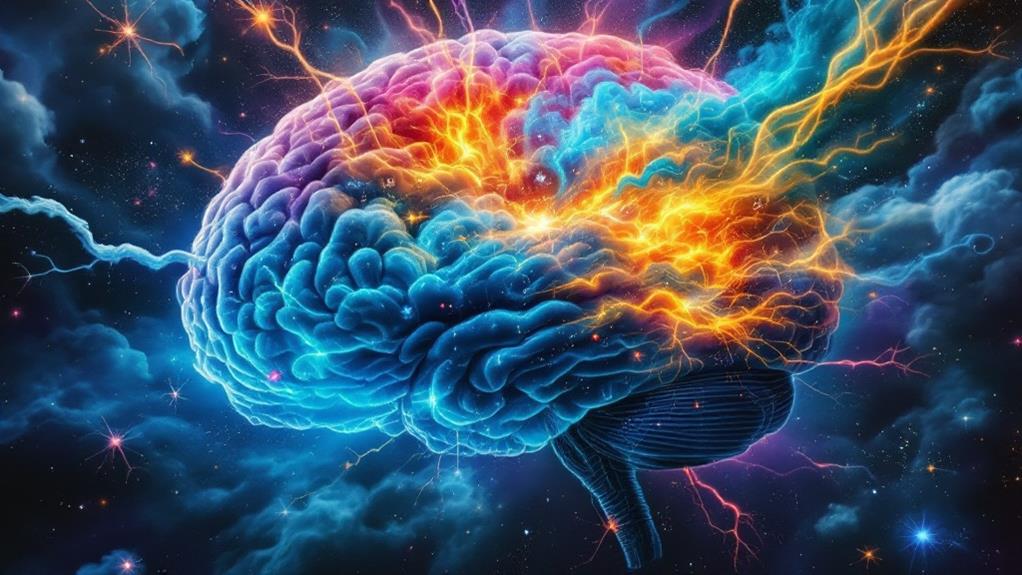How Does Dream Interpretation Work? a Look Into the Psychology of Dreams

Dream interpretation helps you uncover the hidden layers of your subconscious and emotional health. Freud's theory suggests dreams reveal unmet desires, whereas Jung emphasizes universal symbols shared by humanity. Cognitive perspectives see dreams as mirrors of your thoughts and concerns. Dream analysis allows you to reflect on recurring motifs or symbols, such as dreaming of falling, which might indicate insecurity. Keeping a dream diary sharpens recall, helping identify patterns and unresolved issues. Since dreams are influenced by your emotions and experiences, they can highlight what you're avoiding. There's more to investigate in understanding how dreams influence your waking life.
Defining Dreams and Their Types
Dream interpretation often begins with understanding what dreams are and the types they encompass. Dreams are involuntary sequences of images, emotions, and sensations that primarily occur during REM sleep. You experience a range of types of dreams, including Passive Imaginations, Illusions, and Hallucinations. These types reflect different interactions between your subconscious mind and external stimuli.
Dreams serve several psychological functions. They play an essential role in memory consolidation, where your brain organizes and stores information. Emotional processing is another important function; dreams help you work through feelings and past experiences, providing a safe space for exploration. You might find that dream content becomes more vivid when you're emotionally charged or stressed.
Most people experience 3 to 6 dreams each night, although a staggering 95% are forgotten upon waking. The quality of your sleep can greatly affect dream content and vividness. Sleep disorders, such as sleep apnea, can disrupt REM sleep, leading to less vivid dreams or altered dream patterns. Understanding these elements helps you appreciate how dreams reflect your subconscious mind and their potential impact on your waking life. This awareness is essential for interpreting dreams' meanings and psychological significance.
REM Sleep and Its Role
REM sleep, or Rapid Eye Movement sleep, plays a vital role in dream formation and mental restoration. During this phase, your brain activity mirrors that of waking consciousness, which is why you experience vivid dreams. On average, you go through 3 to 6 dreams per night, with each lasting between 5 to 20 minutes. These dreams mainly occur during REM sleep, which makes up about 20-25% of your total sleep time. As the sleep cycle repeats roughly every 90 minutes, REM sleep becomes an important period for your brain to process and consolidate information.
Waking up during REM sleep greatly improves your chances of dream recall. Your brain is actively engaged, making it easier to remember the vivid dreams you experience. However, sleep disorders, such as sleep apnea or insomnia, can disrupt your REM sleep. This disruption often results in reduced dream quality and an increase in negative dream experiences, like nightmares. These disturbances can affect your overall sleep cycle and leave you feeling unrested. Understanding REM sleep's impact on your dreams can help you identify potential issues and improve your sleep quality, ensuring your mind and body get the revitalization they need.
Freud's Dream Theory

In Sigmund Freud's view, dreams serve as a window into our unconscious mind, acting as a form of wish fulfillment that reveals hidden desires and unresolved conflicts. Freud's dream theory suggests that dreams are not random but are loaded with meaning, expressed through symbolic representations. He proposed that dreams have two levels: manifest content, the actual storyline you remember, and latent content, the hidden meaning reflecting your unconscious desires. This distinction is essential for dream interpretation.
Freud introduced the concept of dream work, a process that transforms latent content into manifest content, making your dreams more palatable to the conscious mind. This transformation involves mechanisms like condensation, where multiple ideas merge into one, and displacement, where emotional significance shifts from one idea to another. Symbolization turns complex thoughts into simple images, while secondary revision makes the dream coherent upon waking.
Freud believed that your dreams disguise unpleasant thoughts and feelings, often rooted in childhood experiences and repressed memories. These elements connect your dreams to broader psychological issues, providing insight into your inner conflicts and desires. Understanding Freud's dream theory offers a fascinating glimpse into how the unconscious mind communicates through dreams, helping you investigate your psychological landscape.
Jung's Dream Interpretation
Carl Jung's approach to dream interpretation builds on Freudian principles by introducing the concept of archetypes, which are universal symbols and themes present in our dreams. These archetypes tap into the collective unconscious, reflecting shared human experiences. Jung believed that dream interpretation serves as a compensatory mechanism, helping you balance conflicts in your conscious mind while offering insights into your psyche.
In dream analysis, Jung identified four primary archetypes: the anima, the animus, the shadow, and the persona. The anima represents the feminine aspect within men, while the animus embodies the masculine aspect within women. The shadow consists of repressed parts of yourself, and the persona is the social mask you present to the world. Understanding these archetypes in your dreams can reveal symbolic messages about your inner conflicts and desires.
Jung emphasized the personal significance of dream symbols, noting that their meanings vary based on your individual experiences and cultural background. To explore deeper into your dreams, he advocated for active imagination techniques. This approach encourages you to creatively engage with your dreams, fostering a richer investigation of their symbolic messages and facilitating greater self-awareness.
Cognitive and Behavioral Views

While Jung's theory highlights the symbolic richness of dreams, cognitive and behavioral views offer a different perspective by focusing on the practical aspects of dreaming. Cognitive theories, like those of Calvin S. Hall, propose that dreams reflect your personal thoughts and experiences, acting as a mirror to how you perceive yourself and your relationships. This approach suggests that your dream content serves as a window into your self-conception and daily life intricacies, providing insights into your mental state.
On the other hand, behavioral perspectives focus on learned associations and responses, viewing dreams as conditioned reactions to waking life stimuli. This implies that what you experience daily can shape your dream narratives, turning them into a stage for emotional experiences and problem-solving. When you engage in dream analysis, these perspectives help you understand how your dreams might address unresolved issues or stressors.
Cognitive Behavioral Therapy (CBT) techniques can also be applied to dream analysis. By reframing negative dream narratives, you can address underlying anxiety or stress, offering a therapeutic pathway to improve your coping mechanisms. Ultimately, the interplay between cognitive processes and emotions in dreams offers valuable insights into your emotional resilience and personal growth.
Neuroscientific Insights on Dreams
Dreams, a captivating feature of human sleep, primarily occur during the rapid-eye-movement (REM) stage when brain activity closely mirrors wakefulness. Neuroscientific research has shown that during REM sleep, your brain engages in complex processes that contribute considerably to emotional processing and memory consolidation. These functions help you integrate and organize experiences from your waking life, which is why dreaming is considered crucial for maintaining psychological well-being.
The average person experiences between 3 to 6 dreams each night, although they're often forgotten upon waking. Curiously, the threat simulation theory suggests that dreaming helps you rehearse real-life threats, enhancing your ability to navigate challenges and improve survival strategies. This theory adds an engaging dimension to dream interpretation, highlighting dreams' potential utility in preparing you for real-world scenarios.
However, disruptions in REM sleep can lead to increased nightmares, negatively affecting your psychological well-being. Neurological evidence underscores the significance of quality sleep for effective emotional processing and memory consolidation. By understanding the neuroscientific insights on dreams, you can appreciate how these nightly narratives not only reflect but also influence your mental health and daily life experiences.
Common Dream Themes

With an understanding of the brain's role in dreaming, it's intriguing to investigate the common themes that populate our nocturnal narratives. Dreams about being chased often signify avoidance of stress or unresolved issues. When you find yourself running in your dreams, it might be time to confront what's troubling you. Falling is another prevalent dream theme, usually representing feelings of insecurity or a loss of support in your waking life. Such dreams can prompt reflection on your emotional stability and support systems.
Another theme involves losing teeth, often linked to anxiety regarding self-image or aging. Interpretations vary, but they typically highlight concerns about personal loss or changes, sometimes even touching on underlying sexual connotations. Recurring dreams are particularly telling, signaling unresolved issues or stressors in your life. These dreams urge emotional processing and attention to specific concerns, playing an essential role in your mental health.
Exam scenarios in dreams point to feelings of inadequacy or fear of failure, reflecting anxiety about real-life performance. Finally, dreams of natural disasters like floods or earthquakes symbolize significant stressors or traumatic experiences, indicating emotional turmoil. Understanding these dream themes can guide you toward effective psychological approaches for addressing these issues.
Biases in Dream Analysis
In exploring the domain of dream analysis, biases often cloud our interpretations, shaping how we perceive and respond to our dreams. Negative dreams, especially those involving disliked individuals, tend to linger in your mind, causing you to interpret them with a pessimistic slant. This skewed view can overshadow the broader psychological importance of the dream. Furthermore, confirmation bias might lead you to interpret dreams in ways that reinforce your current beliefs or emotions, ignoring alternative explanations that might offer deeper insights.
Self-serving bias can also play a role, as you may interpret dream content to bolster your self-image or justify your behavior, which can compromise the accuracy of your analysis. Recurring dreams often hint at unresolved issues, and your current emotional experiences might color how you perceive these dreams, introducing personal biases into the interpretation process. Such biases can greatly influence behavior outcomes, sometimes resulting in self-fulfilling prophecies. If you believe a dream predicts a certain event, your actions might inadvertently bring that event to pass. Understanding these biases is vital, as it allows you to approach dream analysis with a more balanced and open mind, enhancing the interpretative process.
Dreams and Mental Health

Although often seen as mysterious and abstract, dreams can offer significant insights into your mental health. They reflect your mental and emotional states, highlighting underlying issues like anxiety or stress. The interpretation of dreams can reveal unconscious thoughts and emotional challenges you might be facing. Research links negative dreams with heightened distress, while pleasant dreams often indicate peace of mind. This psychological association between dreams and mental health can be a valuable tool for understanding your inner world.
Nightmares, which affect about 5% of adults, are often tied to trauma, anxiety, or sleep disorders. These distressing dreams can cause significant daytime fatigue and emotional distress. They may function as a mechanism to process fears and unresolved emotional turmoil, acting like a rehearsal for real-life challenges. Keeping dream diaries can help track these patterns, offering insights into your mental well-being.
Consulting with mental health professionals can further aid in interpreting dreams, providing clarity and facilitating therapeutic progress. By understanding the connection between your dreams and mental health, you can address underlying issues, improve your mental well-being, and gain deeper awareness of your psychological landscape.
Analyzing Your Own Dreams
Interpreting your own dreams can provide personal insights and improve self-awareness. Start by keeping a dream diary to jot down your dreams immediately upon waking. This practice boosts recall and helps you identify recurring themes or symbols in dreams that might hold personal significance. By regularly writing down your dreams, you can spot patterns and common symbols that might highlight areas of concern or interest in your waking life.
Analyzing emotions experienced during your dreams is essential. These emotions can reveal unresolved personal issues or stressors affecting your daily life. For example, feeling anxious or chased in a dream might suggest you're avoiding something significant. Understanding these symbols in dreams, like falling teeth representing anxiety, can be a gateway to deeper dream interpretations.
To further contextualize dreams, reflect on recent events or challenges. This reflection helps clarify how dreams relate to your current emotional state or concerns. Discussing your dreams with others or seeking professional guidance can also provide new perspectives, enriching your understanding of subconscious thoughts and feelings. Ultimately, analyzing your dreams offers a unique window into your mind, revealing insights tied to your life's expedition.




